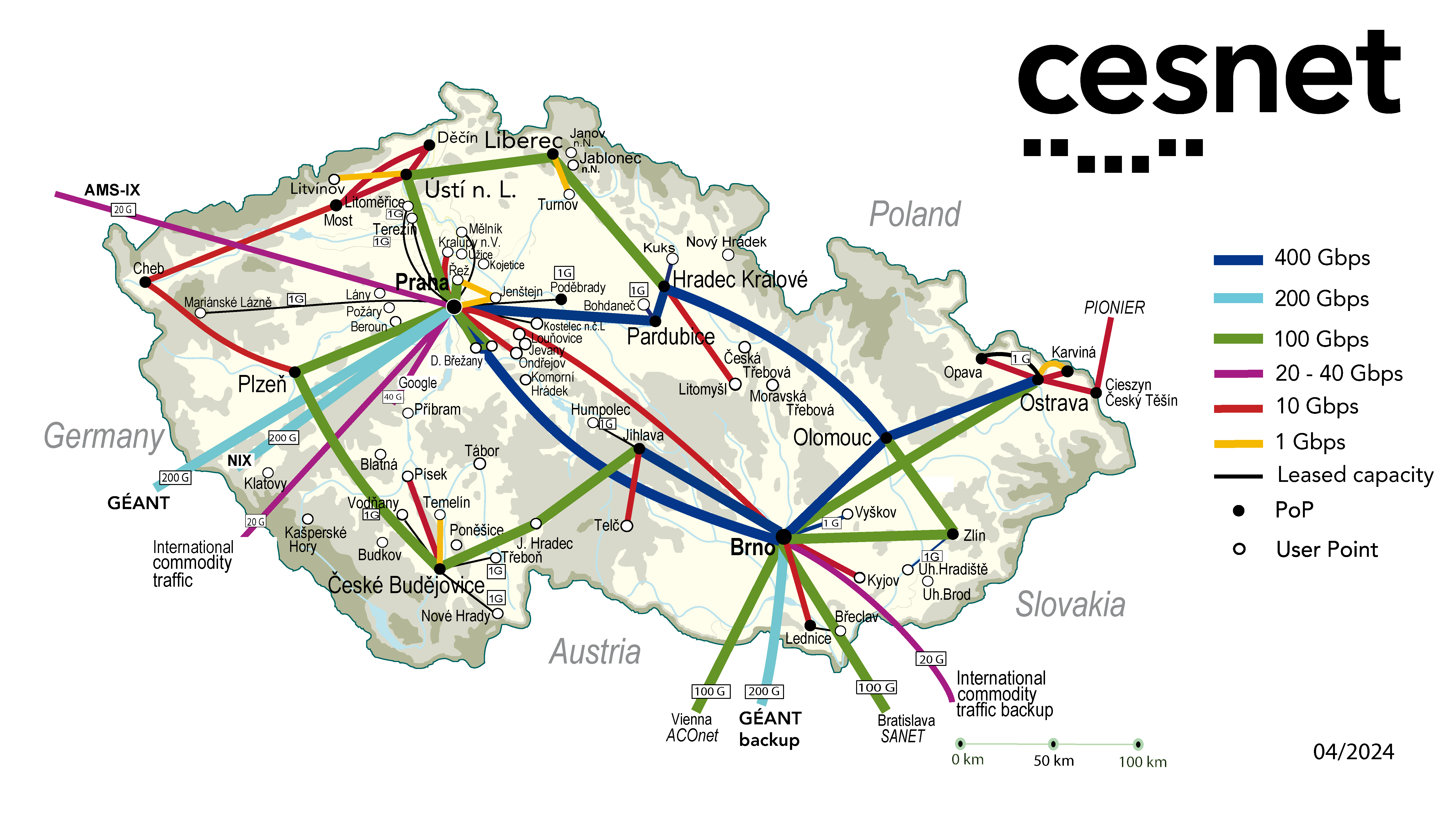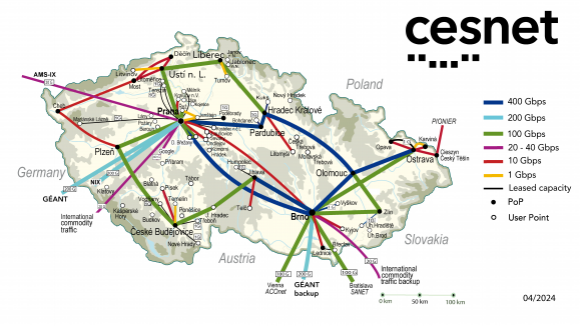The CESNET3 network
The backbone of our e-Infrastructure
The cornerstone of CESNET's e-infrastructure is the high-speed CESNET3 network. This advanced backbone connects the major university cities and other regions of the Czech Republic through circuits with exceptionally high transmission speeds. Besides providing standard Internet access and substantial bandwidth for scientific and research purposes, CESNET3 offers a range of modern services, including video conferencing, the MetaCentre supercomputer, and IP telephony.
Key Features
-
Advanced Network Specifications: CESNET3 features cutting-edge infrastructure with high bandwidth (typically ranging from 10 to 400 Gb/s), high redundancy, and a multi-layer connection. This robust optical backbone allows connected organizations to use demanding applications like multimedia transmissions, data resource sharing, and access to computing or experimental equipment.
-
End-to-End Services: Tailored to user needs, these dedicated connections link a limited number of devices, enabling the transmission of large data volumes. These connections operate independently from the main network, avoiding competition for bandwidth with regular traffic. We also offer these services internationally.
-
Virtual Private Networks (VPNs): VPNs provide secure connections between defined points, segregating their communication from general network traffic. Although they share transmission capacity with others, VPNs are ideal for securing sensitive data flows.
-
High Reliability: The network’s reliability is ensured through redundant backbone infrastructure (with each node having at least two independent connections) and continuous network monitoring. Backup connections are typically scaled to match the primary connections, which is uncommon in other networks. Users can depend on consistent and high-quality service availability.
Network Topology
CESNET3’s core is built on a sophisticated DWDM (Dense Wavelength Division Multiplexing) infrastructure, featuring multiple transmission channels operating at speeds of 400, 100, 40, 10, and 1 Gbps. Since launching the first DWDM route between Prague and Brno in 2005, we upgraded the backbone to 100 Gb/s in 2013 and are currently enhancing it to 400 Gb/s in 2022 and 2023.
The network also includes 100-gigabit, 10-gigabit, and 1-gigabit Ethernet circuits, with routes to smaller nodes typically offering 10 Gbps. Capacity is continuously adjusted to meet demand and operational needs.
CESNET3’s topology is designed with circular routes connecting a select number of cities (ideally up to four per circle). This setup ensures a redundant network backbone with minimal delays due to shorter paths through active network elements.
The CESNET3 network topology
Network Layer Support
CESNET3 supports both IPv4 and IPv6 at the network layer. We also provide transmission services at lower layers, including:
- Dedicated circuits (End-to-End Services): Custom circuits that offer direct connections for large data transfers.
- Lambda services: High-capacity, dedicated wavelength channels for data transmission.
- Photonic services: Advanced optical network services for demanding applications.
Connectivity
CESNET3 has robust connections with international networks:
- European GÉANT Network: Our direct connection to GÉANT, located on CESNET premises, features redundant 200 Gb/s links. This primarily supports traffic between academic institutions.
- Commercial Internet: We connect to the commercial Internet through a redundant 20 Gb/s Tier2 line provided by Telecom Italia.
- National Research Networks: We have connections to three national research and education networks in neighboring countries:
- SANET (Slovakia) with 100 Gbps
- ACONET (Austria) with 100 Gbps
- PIONIER (Poland) with 10 Gbps
- Google Network: We maintain a separate 40 Gb/s connection to Google.
Peering Centres
Our external transmission capacity is further enhanced through peering centres:
- NIX.CZ: 2x 100 Gb/s links for peering with domestic Internet providers. We are also involved in the FENIX security project within NIX.CZ.
- AMS-IX: 2x 10 Gb/s links for peering with selected international providers.
You can view the current load on our backbone network via our traffic map.


